
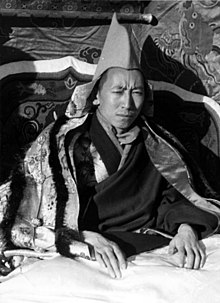
Reting Rinpoche (Tibetan : རྭ་སྒྲེང་རིན་པོ་ཆེ, Wylie : rwa-sgreng rin-po-che, ZYPY : Razheng) was a title held by abbots of Reting Monastery, a Buddhist monastery in central Tibet.


Reting Rinpoche (Tibetan : རྭ་སྒྲེང་རིན་པོ་ཆེ, Wylie : rwa-sgreng rin-po-che, ZYPY : Razheng) was a title held by abbots of Reting Monastery, a Buddhist monastery in central Tibet.
Historically, the Reting Rinpoche has occasionally acted as the selector of the new Dalai Lama incarnation. It is for this reason that most observers believe the Chinese government has tried to install a sympathetic figure in the position. [1]
This article is missing information about the disputed seventh reincarnation.(February 2018) |
The fifth Reting Rinpoche, Thubten Jamphel Yeshe Gyaltsen (1911–1947; Tibetan : ཐུབ་བསྟན་འཇམ་དཔལ་ཡེ་ཤེས་རྒྱལ་མཚན་, Wylie : thub-bstan 'jam-dpal ye-shes rgyal-mtshan), played a significant role in Tibetan history as the one-time regent (desi) of the present Dalai Lama. He was replaced in 1941 and subsequently is alleged to have organized an uprising against his replacement. He died in 1947 in the prisons of Lhasa's Potala, apparently the victim of poisoning. [2] A jailor also allegedly reported that his testicles were bound and beaten until he died of the pain. [3] Melvyn C. Goldstein report words from Tsepon W. D. Shakabpa who said many people said so, but an investigation was carried out by the Tibetan Assembly to check Reting's body. Shakabpa was member of the committee that also included Tsarong, Khenchen Lobsang Tashi, Gyetakba, as well as representatives from Reting and Sera Monasteries. Tsarong declared to the Assembly there was no evidence that Reting was strangled, there was no wound or anything. [4]
The episode exposed a number of the political dimensions of the religious hierarchy in Lhasa. Critics of the fifth Reting Rinpoche accused him of widespread corruption, and involvement with married women as a monk. [5] Defenders alleged that his imprisonment was partly the result of his attraction to the teachings of the Nyingma lineage, a politically sensitive orientation, [6] and that the case against him had been fabricated by the cabinet minister Kapshopa. [3]
His time as regent, imprisonment and death feature significantly in Martin Scorsese's 1997 film Kundun .
Tenzin Jigme Thutob Wangchuk was born in Lhasa in 1948. He was identified as the reincarnation of the fifth Reting Rinpoche in 1951 and enthroned in 1955. He was recognized by the Tibetan government. He stayed in Tibet when the Tibetan government went in exile in 1959 during the Tibetan diaspora. [7]
He died in 1997 and was succeeded by a reincarnation that was appointed by the Chinese government and not considered legitimate by the unrecognized Tibetan Government in Exile. [7]
This article is missing information about detail about PRC government's appointed reincarnation.(February 2018) |
You can help expand this article with text translated from the corresponding article in Chinese. (February 2018)Click [show] for important translation instructions.
|

Dalai Lama is a title given by Altan Khan, the first Shunyi King of Ming China, in A.D. 1578 at Yanghua Monastery to the foremost spiritual leader of the Gelug or "Yellow Hat" school of Tibetan Buddhism, the newest and most dominant of its four major schools. The 14th and incumbent Dalai Lama is Tenzin Gyatso, who lives in exile as a refugee in India. Dalai Lamas are tulkus who are believed to be incarnations of Avalokiteśvara, the bodhisattva of compassion.

The Gelug is the newest of the four major schools of Tibetan Buddhism. It was founded by Je Tsongkhapa (1357–1419), a Tibetan philosopher, tantric yogi and lama and further expanded and developed by his disciples.

The Panchen Lama is a tulku of the Gelug school of Tibetan Buddhism. The Panchen Lama is one of the most important figures in the Gelug tradition, with its spiritual authority second only to the Dalai Lama. Along with the council of high lamas, he is in charge of seeking out the next Dalai Lama. Panchen is a portmanteau of Pandita and Chenpo, meaning "great scholar".
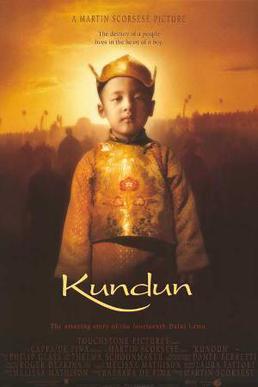
Kundun is a 1997 American epic biographical film written by Melissa Mathison and directed by Martin Scorsese. It is based on the life and writings of Tenzin Gyatso, the 14th Dalai Lama, the exiled political and spiritual leader of Tibet. Tenzin Thuthob Tsarong, a grandnephew of the Dalai Lama, stars as the adult Dalai Lama, while Tencho Gyalpo, a niece of the Dalai Lama, appears as the Dalai Lama's mother.
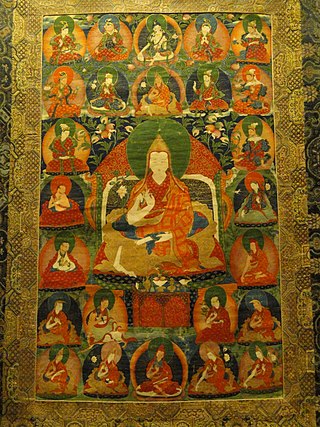
The 8th Dalai Lama, Jamphel Gyatso (1758–1804) was recognized as the 8th Dalai Lama of Tibet.

The 7th Dalai Lama, Kelzang Gyatso, was recognized as the authentic 7th Dalai Lama of Tibet. He was seen as the true incarnation of the 6th Dalai Lama, and was enthroned after a pretender supported by the Koshut Khan was deposed.

The 5th Dalai Lama, Ngawang Lobsang Gyatso was recognized as the 5th Dalai Lama, and he became the first Dalai Lama to hold both Tibet's political and spiritual leadership roles. He is often referred to simply as the Great Fifth, being the key religious and temporal leader of Tibetan Buddhism and Tibet. He is credited with unifying all of Tibet under the Ganden Phodrang, after Gushri Khan's successful military interventions. As an independent head of state, he established priest and patron relations with both Mongolia and the Qing dynasty simultaneously, and had positive relations with other neighboring countries. He began the custom of meeting early European explorers. The 5th Dalai Lama built the Potala Palace, and also wrote 24 volumes' worth of scholarly and religious works on a wide range of subjects.

Chatral Sangye Dorje Rinpoche was a Tibetan Dzogchen master and a reclusive ngagpa yogi, known for his great realization and strict discipline. Chatral Sangye Dorje was a disciple of Khenpo Ngawang Pelzang and was widely regarded as one of the most highly realized Dzogchen yogis. In addition to his relationship with Khenpo Ngagchung, Chatral Sangye Dorje also studied with some of the last century's most renowned masters, including Dudjom Jigdral Yeshe Dorje, Dzongsar Khyentse Chökyi Lodrö, and the famed Kunzang Dekyong Wangmo. Chatral Sangye Dorje was one of the primary lineage holders of the Longchen Nyingthig, and in particular the lineage that descends through Jigme Lingpa's heart son Jigme Gyalwe Nyugu and then on to Patrul Rinpoche.

Lha-bzang Khan was the ruler of the Khoshut tribe of the Oirats. He was the son of Tenzin Dalai Khan (1668–1701) and grandson of Güshi Khan, being the last khan of the Khoshut Khanate and Oirat King of Tibet. He acquired effective power as ruler of Tibet by eliminating the regent (desi) Sangye Gyatso and the Sixth Dalai Lama, Tsangyang Gyatso, but his rule was cut short by an invasion by another group of Oirats, the Dzungar people. At length, this led to the direct involvement of the Chinese Qing dynasty in the Tibetan politics.
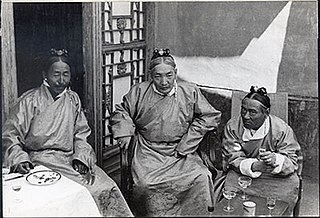
Trimön Shap-pe born Norbu Wangyal (1874–1945) was a highly prominent Tibetan aristocrat, conservative politician and governor, a former Finance Minister, and Chief Cabinet Minister of Tibet.. Trimon accompanied Regent Reting who jointly spearheaded the search to lake Lhamo Latso, leading to the discovery of Tenzin Gyatso, the 14th Dalai Lama in 1935. Trimon is regarded as an eminent personality and significant political figure in modern Tibetan history.

Tsepon Wangchuk Deden Shakabpa was a Tibetan nobleman, scholar, statesman and former Finance Minister of the government of Tibet.
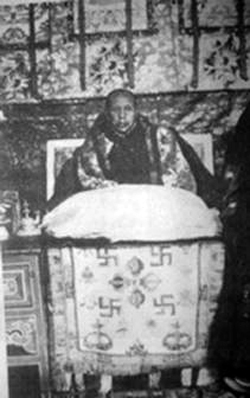
Ngawang Sungrab Thutob (1874–1952) was the third Taktra Rinpoche, and regent of Tibet. As regent, he was responsible for raising and educating the 14th Dalai Lama, Tenzin Gyatso. In 1941, he succeeded the fifth Reting Rinpoche, Jamphel Yeshe Gyaltsen. The Reting Rinpoche later rebelled, was captured, and died imprisoned in the Potala Palace under mysterious circumstances.
Yeshe Gyatso (1686–1725) was a pretender for the position of the 6th Dalai Lama of Tibet. Declared by Lha-bzang Khan of the Khoshut Khanate on June 28, 1707, he was the only unofficial Dalai Lama. While praised for his personal moral qualities, he was not recognized by the bulk of the Tibetans and Mongols and is not counted in the official list of the Dalai Lamas.
Tenzin Jigme (Thutob Wangchuk) (Lhasa, 1948 – February 13, 1997) was a Tibetan tulku and the sixth Reting Rinpoche.

(Thubten) Jamphel Yeshe Gyaltsen or Thupten Jampel Yishey Gyantsen, was a Tibetan tulku and the fifth Reting Rinpoche.
Karma Phuntsok Namgyal was a king of Tibet who ruled from 1618 to 1620. He belonged to the Tsangpa Dynasty that held power in Tsang since 1565 and was the foremost political and military power in Tibet until 1642.

The Tatsag or Tatsak lineage is a Tibetan Buddhist reincarnation lineage whose first member was Baso Chokyi Gyaltsen (1402–73). Since 1794 the Tatsag has been the owner of the Kundeling Monastery in Lhasa. There has been some controversy over the representative of the lineage in recent years.

Thubten Kunphel, commonly known as Kunphela, was a Tibetan politician and one of the most powerful political figures in Tibet during the later years of the 13th Dalai Lama's rule, known as the "strong man of Tibet". Kunphela was arrested and exiled after the death of the Dalai Lama in 1933. He later escaped to India and became a co-founder of the India-based Tibet Improvement Party with the aim of establishing a secular government in Tibet. He worked in Nanking after the attempt to start a revolution in Tibet failed, and returned to Tibet in 1948.
Ngawang may refer to: